When lining buried concrete tanks/pits a key consideration is the risk of osmosis. The concrete acts as a semi permeable membrane, which if ground water is present can lead to osmotic blistering in the new tank lining.
To mitigate this, we proposed the application of Aquron 2000 waterproofing treatment. This Colloid Silicate penetrates up to 200mm into the concrete that is being treated and forms a hydrogel, that prevents the transmission of moisture, thus significantly reducing the risk of osmosis.
This strategy was vindicated as during the works we experienced water ingress around pipe penetrations and between the joints in the concrete rings. To resolve this we conducted resin injection works using Normet Tampur 150 initially.
Around the pipes further sealing works were undertaken by breaking out a recess prior to filling using Remmers Stopaq swellable sealant. This works by expanding when it contacts moisture, forming a pressure seal that can withstand ground water pressure.
To ensure the Stopaq material was retained in place as it expands a fillet detail was formed around the pipe using Remmers Betofix mortars.












